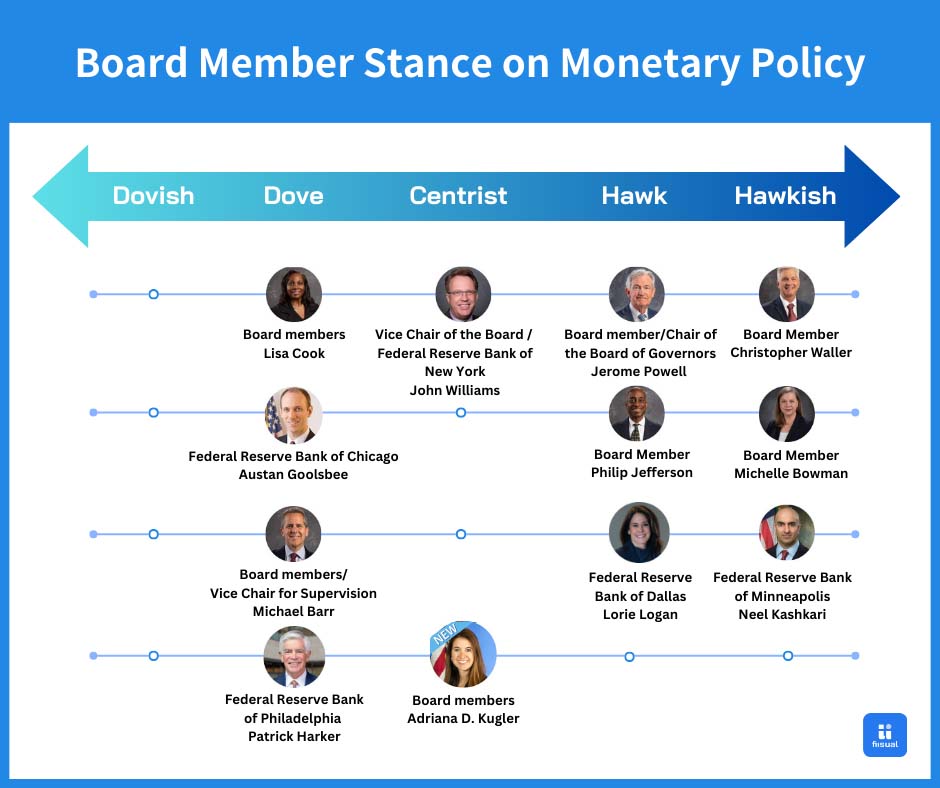After the previous introductions, you’re likely familiar with the Federal Open Market Committee (FOMC), which serves as the central decision-making body of the Federal Reserve System. All of the Fed’s monetary policy decisions, including whether to raise or lower interest rates, are determined through FOMC discussions. Members’ stances and perspectives can vary significantly.
Before introducing the individual members, let’s take a closer look at the eligibility requirements for FOMC membership.
FOMC Membership Eligibility
As previously mentioned, the FOMC includes 12 voting members: the 7 fixed voting members from the Board of Governors, and the New York Fed president, who holds a permanent voting seat due to the unique role of the New York Reserve Bank.
In summary:
FOMC 12 Members = 7 Board of Governors members + New York Fed President + 4 Rotating Regional Bank Presidents
The four rotating voting seats are filled by presidents from the remaining eleven regional Reserve Banks on an annual rotation basis. Although the New York Fed president has voting rights similar to the Board members, they are technically still a regional bank president. Therefore, the New York Fed also participates in the rotation by appointing the New York Fed’s vice president as the rotating voting member on behalf of the New York Fed president. If the president is unavailable, the vice president automatically fills in as their substitute.
Board Composition and Their Stance
| 2023 Members | Position | Stance | Term Expires Date |
|---|---|---|---|
| Jerome H. Powell | Chair of the Board of Governors | Hawkish | 2028/1/31 |
| John C. Williams | Vice Chair of the Board / New York Fed President | Hawkish | |
| Michael S. Barr | Vice Chair for Supervision | Hawkish | 2032/1/31 |
| Michelle W. Bowman | Board Member | Hawkish | 2034/1/31 |
| Lisa D. Cook | Board Member | Neutral, dovish | 2034/1/31 |
| Christopher J. Waller | Board Member | Hawkish | 2030/1/31 |
| Philip N. Jefferson | Board Member | Hawkish | 2036/1/31 |
| Adriana D. Kugler | New Board Member | -- | 2036/1/31 |
Adriana D. Kugler joined on 2023/09/13 as the most recently appointed Board member.
The chart above highlights several key points:

- The Federal Reserve Board is predominantly hawkish From the recent rate hike path, we can see that the U.S. has experienced one of the fastest rate hikes in history. The decisive hikes, apart from addressing soaring inflation, were also thanks to the stance of these Board members.
- Practice of staggered terms Observing the terms, we can see that each Board member’s end/start period is staggered by two years. This is mandated by the “Federal Reserve Act” to prevent external forces from gaining control over monetary policy.
FOMC Voting Members: Composition, Terms, and Stances
| 2023 FOMC Voting Members | FOMC Role/Position | Stance | Term & Appointment |
|---|---|---|---|
| Neel Tushar Kashkari | Rotating Voting Member / Minneapolis Fed President | Hawkish | |
| Austan D. Goolsbee | Rotating Voting Member / Chicago Fed President | Dovish | 2024 Alternate Voting Member |
| Lorie K. Logan | Rotating Voting Member / Dallas Fed President | Hawkish | |
| Patrick Harker | Rotating Voting Member / Philadelphia Fed President | Hawkish | |
| Thomas I. Barkin | Alternate Voting Member / Richmond Fed President | Hawkish | 2024 Voting Member |
| Raphael W. Bostic | Alternate Voting Member / Atlanta Fed President | Neutral | 2024 Voting Member |
| Mary C. Daly | Alternate Voting Member / San Francisco Fed President | Dovish | 2024 Voting Member |
| Loretta J. Mester | Alternate Voting Member / Cleveland Fed President | Hawkish | 2024 Voting Member |
| Sushmita Shukla | Alternate Voting Member / New York First Vice President | Unknown | 2024 Voting Member |
| Susan M. Collins | Non-Voting Rotating Member / Boston Fed President | Neutral | 2024 Alternate Voting Member |
| Vacant | Non-Voting Rotating Member / Kansas City Fed President | 2024 Alternate Voting Member | |
| James Bullard | Non-Voting Rotating Member / St. Louis Fed President | Hawkish | 2024 Alternate Voting Member, resigned as Fed President on 8/15 |
The seven Board members and the New York Fed president, along with the rotating voting members for the year, make up the FOMC’s total of 12 voting members.
Each regional Fed president has the opportunity to serve as a voting member on the FOMC, so broadly speaking, all regional bank presidents can be considered part of the FOMC.
During meetings, these Fed presidents and Board members gather to discuss monetary policy, with the final policy decision being made by a vote from the 12 FOMC members. The New York Fed’s trading desk then implements this policy through open market operations.
Members’ stances are generally inferred from their past statements. For those interested in learning more, you can explore the Federal Reserve’s official website or the regional Fed websites to find speeches, research, and insights from these presidents. This will help you better understand each member's views on current interest rate policies and the broader economy.
That concludes our introduction to the FOMC and its members!
